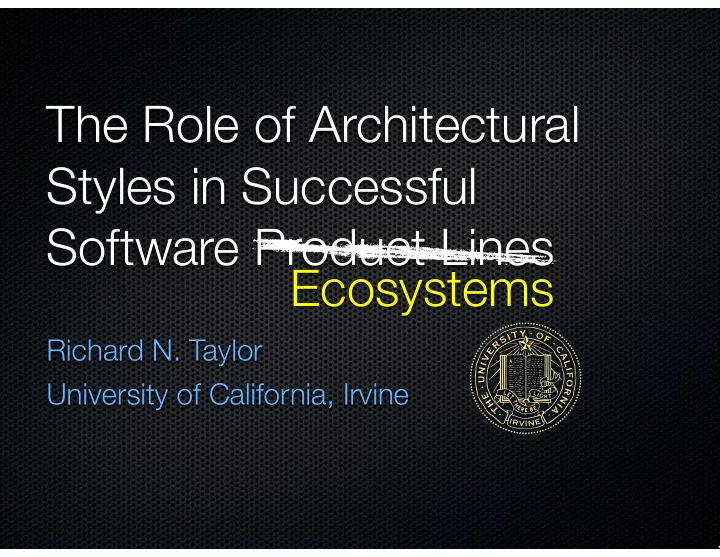

The Role of Architectural Styles in Successful Software Product Lines Ecosystems Richard N. Taylor University of California, Irvine
The End at the Beginning Take-away #1: A well-chosen, well- designed architectural style is key to a successful product line or ecosystem Take-away #2: Multi-agency, decentralized applications offer special challenges and demand new approaches (Especially when you care about $$$ and security) (And we have some ideas…)
Unpacking the Title... An architectural style is a named collection of architectural design decisions that (1) are applicable in a given development context, (2) constrain architectural design decisions that are specific to a particular system within that context, and (3) elicit beneficial qualities in each resulting system.
Shallow Deep Application Domain Knowledge Programming (language level) (Program) patterns Design Application structure (components & Architectural Scope patterns connectors) Styles software architectures Domain-speci fi c System structure
Success? What’s That? Profit? Yes ! Decreased time to market? Widespread use? Adaptability?
Product Lines & Ecosystems Product Line: separate products that share significant technical commonality in components and structure Examples: Philips TV sets; the iPhone family Ecosystem: a complex system composed of multiple organisms, interacting with it and with each other Examples: Amazon, Photoshop, Apple’s iOS Apps
Product Line Success Stories Philips televisions and medical devices Samsung consumer electronic devices Automotive applications Software product line Hall of Fame: http://splc.net/fame.html
Styles and Ecosystem Success Example #1: Apple iOS Apps “MVC is central to a good design for any iOS app or Mac app.”
iOS App Design & Dev Architectural Styles (aka Design Patterns) MVC Event Notification Frameworks Cocoa and Quartz Foundation, UIkit, Core Graphics Guidance and guidelines “iOS Human Interface Guidelines” XCode SDK
Example #2: Photoshop
Example #3: Web Services “The world of web services has been on fast track to supernova ever since the architect astronauts spotted another meme to rocket out of pragmatism and into the universe of enterprises. But, thankfully, all is not lost. A renaissance of HTTP appreciation is building and, under the banner of REST, shows a credible alternative to what the merchants of complexity are trying to ram down everyone’s throats; a simple set of principles that every day developers can use to connect applications in a style native to the Web.” -- David Heinemeier Hansson, Foreword to RESTful Web Services.
RESTful Design Principles Addressability of information (via URLs) Context-free interactions (application state on the client; resource state on the server) Links and connectedness (HATEOAS) Appropriate use of the uniform interface (i.e. GET, PUT, DELETE, HEAD, POST)
Product Lines v. Ecosystems Product Lines often single agency success criteria: reduced dev costs; faster time to market; higher quality (esp. initial quality) Ecosystems: multi-agency widely varying success criteria: profit, visibility, reach, “coolness,” mindshare, functionality
Ecosystems Multiple examples e-commerce, healthcare, defense, space systems, power grids, highways, factory automation, ... Multiple objectives Not all of which are shared Not all of which are compatible Not all of which are benign
Styles, Going Forward Styles remain a key element in Product Line/ Ecosystem success A well-chosen, well-designed architectural style is key to a successful product line or ecosystem Why? Styles carry experience, aid Conceptual Integrity communication, provide vocabulary, speed design, yield predictable benefits But what style for open, decentralized, critical ecosystems, with weeds?
COmputAtional State Transfer (COAST) The COAST style: For decentralized applications (the context) Based on mobile computations, communication constraints, POLA (the constraints) Yields dynamic adaptability, pervasive security, ... (some of the beneficial qualities as architectural consequences) Status: Full infrastructure in place for evaluative applications Seeking application partners Working an electronic healthcare record scenario
Recommend
More recommend